Through structured questionnaire and personal interviews, data were collected from 58 hatcheries and analyzed using descriptive and inferential statistics. Major challenges identified by this study include lack of good quality brood stock, high mortalities during larval development, high costs of hatchery inputs and equipment, water quality maintenance and energy-related problems. It is recommended that government should offer low-interest loans for continuous training of fish hatchery operators, who should be mandated to train regularly to update their knowledge on new developments in the industry. These steps should result in enhanced fish seed production for viable and sustainable aquaculture development in Nigeria.
Introduction
Fish farming is expanding rapidly throughout the world and has a high potential for the provision of valuable protein in less developed countries (Little & Edwards, 2003). Due to global population expansion, demand for high quality animal protein, especially from aquatic sources, is rising. Increasing the aquaculture production is clearly needed to meet this demand in the third millennium, especially as the capture fisheries resources are declining, due to over fishing, habitat destruction, and pollution (Dunham, Majumdar, Hallerman, Bartley, Mair, Hulata, Liu, Pongthana, Bakos, Penman, Gupa, Ratalishbweg & Hoestgen Schwark, 2001).
Aquaculture plays an important role in many developing economies. In Nigeria, aquaculture is gaining increasing importance for employment creation and income generation, particularly in the socio-economically weaker communities of fishermen, which represents the poorest sections of the society in many developing countries (National Informatics Centre, NIC, 2007). Total fish production in Nigeria is estimated at about 30 percent of demand, thus scarce foreign exchange is devoted to the importation of large volumes of frozen fish (ThefishSite, 2009). According to Otubusin (1998), inadequate fish seed supply is a major constraint to aquaculture development in Nigeria.
Although domestication of species and advances in induced breeding have enhanced the breeding of fish in captivity and extend the spawning season to a limited degree, it has not yet allowed substantial seed production outside the normal spawning season for many species. At present, a large percentage of the total seed requirements for aquaculture are obtained from the wild, where supply is completely dictated by the natural breeding cycle of the target species. Domestication and extension of breeding seasons, for example in shrimp production, could have profound influences on productivity and markets. Other factors that cause unpredictability of seed supply include flooding and other natural or man-made disasters, including oil spills, disease outbreaks, and limited availability of feeds for broodstock and larvae (Mair, 2002).
The African catfish, Clarias gariepinus, is the commercial aquaculture species in Nigeria. A major problem identified as hindering the promotion and development of the aquaculture industry in Nigeria has been the scarcity of fish fingerlings. Desired quantity and quality have never been available. While the present total production and supply from all sources is less than 50 million fingerlings, the requirement in the short term is at least 500 million, annually. Until about 15 years ago, no less than 60 per cent of all fish seed supply in Nigeria was from the wild (Bondad-Reantaso, 2007). Many fish farms have been abandoned in the country for lack of fish seed. Many technical problems arise in the production of seed either in the pond or hatchery system. Principal among these are: the lack of and poor management of broodstock, especially feeding and handling; and the poor record keeping of all activities regarding induced spawning, care of eggs, fry, feeding, and general management of fingerlings (Atanda, 2006).
Lack of fish fingerlings has been one of the major constraints for aquaculture development in Nigeria for the past 40 years (Aquaculture and Inland Fisheries Project (AIFP), 2005). Fish seeds are indispensable to the operations of fish farms. Thus, the federal government of Nigeria introduced the fish farm project under which pilot fish farms were established for potential fish farmers to replicate so as to produce more fish for the people. In addition, the Fish Seed Multiplication Project was designed to provide fish farmers with fingerlings with which to stock their ponds (Federal Department of Fisheries (FDF), 1995). However, these projects have, to date, been largely ineffective and could not supply adequate quantities of fish seed for neither the government projects, nor the private individuals (Barker, 1986).
Quality seed and fish feed are the essential components for the fish growth, In promoting seed supply, consideration should be given to the fact that the small localized hatcheries, whilst delivering seed locally, can be more responsive to changing trends in demand, more economically flexible, and have lower start up costs. They can thus play an important role in the sustainability and equity of seed supply and, in many cases, may be more appropriate media for seed distribution than the larger, centralized seed supply systems (Mair, 2002). The potential negative impacts of genetics related to broodstock management issues, such as inbreeding, genetic drift, introgressive hybridization, and unconscious selection, have been well established that many, if not the majority, of aquaculture stocks have been negatively impacted by poor genetic management (Mair, 2002).
Availability of fish seed of the candidate species in adequate quantity is one of the most important factors for a sustainable and profitable fish farming, which involves a number of management practices in the maintenance of quality broodfish in adequate number. In the tropics, most aquaculture species can be grown year round, subject to suitable availability of water and demand for cultured fish is also largely year round, with seasonal troughs and peaks associated with the availability of fish from capture fisheries and cultural preferences. However, for the majority of species, spawning and seed supply is seasonal, thus multiple spawning species are often preferred for successful aquaculture (Mair, 2002).
Objectives of the study
This study attempted to examine the factors affecting the production and management of fish seed in hatcheries and the resultant effect on aquaculture development in Ogun State, Nigeria. The specific objectives were to identify the constraints or limitations to fish seed production and management; examine the role of hatchery fish seed production on the development of aquaculture; and recommend measures that could be taken to ameliorate the scarcity of fish seed in Ogun State, Nigeria.
Materials and methods
The study area, Ogun State, Nigeria lies within 20o45’E and 3o55’E longitude and 7o01’N and 7o8’N latitude in the tropics. Ogun State is bounded in the west by Benin Republic, in the south by Lagos State and the Atlantic Ocean, in the east by Ondo State, and in the north by Oyo state. As shown in Figure 1 below, Ogun State covers a land area of 16,409.28 square kilometers and represents less than two percent of Nigeria’s landmass. The natural vegetation ranges from fresh-water swamp with mangrove forest in the southwest and diverse forest communities to the woody Guinea savannah in the northwest. The rainy season starts around the middle of March and continues till late October, while the dry season starts in November and lasts until February, in most locations. Rainfall ranges between 900 and 1600mm, annually. The area is warm throughout the year with an average temperature ranging between 28 and 350C. Humidity is between 85 and 95 percent (Oloruntoba & Adegbite, 2006).
Like most states in the southwest, Ogun State is highly urbanized, with a population of approximately 3.73 million people and growth rate of about 3 percent, annually, and has about twenty (20) local government areas (The National Population Commission (NPC), 2006). The state was divided into four agricultural extension zones by the Ogun State Agricultural Development Programme (OGADEP) based on agro-ecological features for effective dissemination of improved technologies (Figure 1).
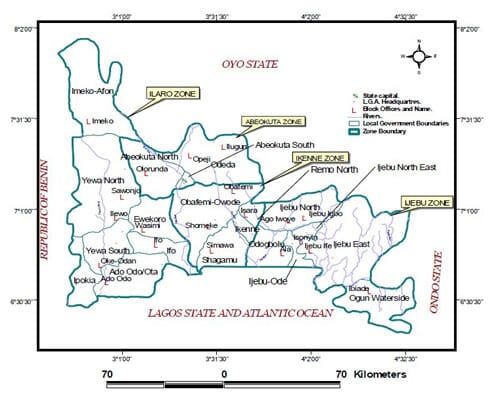
Ogun state has a total water surface area of 2,237,000 hectares and is well endowed with natural water bodies, such as springs, perennial flowing rivers, lakes, and brackish waters, estimated at 173.8 square kilometers (Ita & Sado, 1984). This study was carried out in the Ijebu-Ode, Ilaro, Ikenne, and Abeokuta Agricultural extension operational zones of the Ogun State Agriculture Development Programme (OGADEP). The registered names and location of fish hatcheries located in each zone was collected from OGADEP and unregistered hatcheries identified by registered fish farmers in the state. The names of the hatcheries were arranged in alphabetical order and selected randomly, according to the sample size (50 per cent) of the fish hatcheries in each zones. Table 1, below, describes the sample sizes and population of respondents from each zone.
Table 1: Number of selected hatcheries in the four (4) operational zones of OGADEP

Quantitative data were collected using a structured questionnaire and personal interviews on selected fish hatcheries. These instruments were subjected to content validity analysis by experts in both the Department of Aquaculture and Fisheries Management and the Department of Agricultural Extension and Rural Sociology of the University of Agriculture, Abeokuta (UNAAB). The reliability of this study was based on information supplied by hatchery operators in the selected hatcheries sampled. A reliability coefficient (r) of 0.85 obtained for the instrument was used for data collection. Data were entered and analyzed using the Statistical Package for the Social Sciences (SPSS), Version 12, for regression and sample statistics.
Results and discussion
Socio-economic characteristics of fish hatchery farmers
Fishing activities are the exclusive preservation of people in their active age (FAO, 1997; Oloruntoba & Fakoya, 2002). As presented below, results in Table 2 show that majority (58.62 per cent) of the respondents fell within the active age group of 31-40 years, while 25.86 per cent of the hatchery farmers fell within 21-30 years, 10.34 per cent fell between 41 and 50 years, and 5.17 per cent fell in less than 20 years. This implies that people in the active age are very much involved in fish hatchery enterprise, while the older people may not have enough capital and strength for fish farming. The literacy level is relatively high, as the majority of the farmers (80.66 per cent) had one form of formal education or the other. This phenomenon would assist the respondents to gain access to aquacultural information and acquire skills needed for other income generating fisheries activities. Almost half (44.83 per cent) of fish hatchery farmers had aquaculture experience of 6-9 years. This implies that the farmers had acquired necessary knowledge and skills needed in fish hatchery enterprises for sustainability. Less than half (34.48 per cent) of the respondents got their brood-stock from open markets, followed by personal farm (29.30 per cent). This implies that good and matured brood-stocks are not easy to come by in the study areas.
Table 2: Socio-economic characteristics of fish hatchery Operators
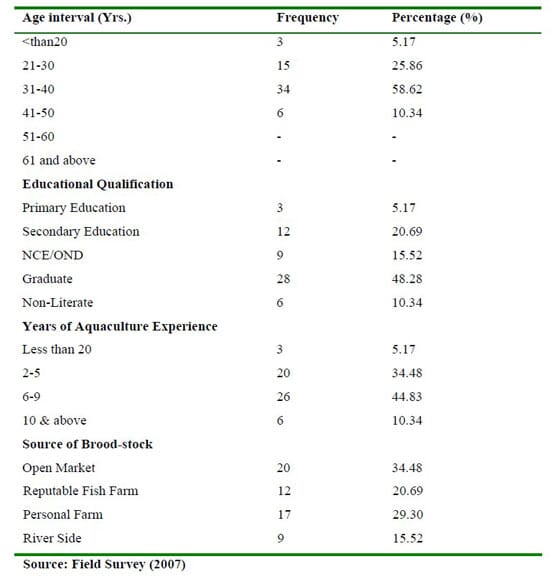
Academic specialization of the respondents
Table 3 shows the academic specialization of the respondents. Only one (1) of the respondents, which represents 4.8 per cent, specialized in fisheries management; 4 (19.0 per cent) specialized in banking & finance / accounting; 1 (4.8 per cent) specialized in farm management, while 3, representing 14.3 per cent, specialized in agriculture; and 2 respondents each, representing 9.5 per cent, specialized in education and business administration, respectively. About 40 percent of respondents did not specify their areas of academic specialization. This implies that the area of academic specialization of the hatchery operator is a major constraint to fish seed production and development. As shown on Table 3 below, that only 4.8 per cent of the respondents specialize in fish farming, but this does not affect the fish seed production and management because it has no significant correlation with monthly fish seed production. The reason may be due to the fact that most of the respondents (85.7 per cent) attended one seminar or the other on fish farming/breeding.
Table 3: Academic specialization of respondents
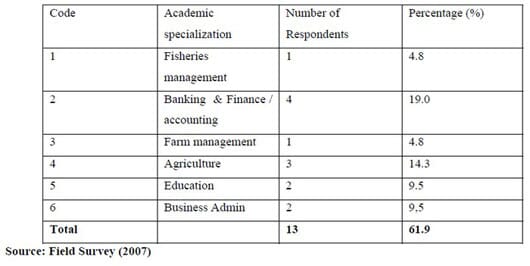
Problems encountered by respondents during fish speed production
Table 4 shows the problems encountered by the respondents during fingerlings production, one of the respondents, representing 4.8 per cent, encountered only low hatchability as a constraint. Three (14.3 per cent) of the respondents also agreed with the problem of fry mortality as a constraint, which concur with Madu (1994), who observed that many hatcheries in Nigeria reported low survival of fish hatchlings. Two (9.5 per cent) respondents mentioned the lack of brood stock, which conformed to Madu (1994), who reported that many hatchery operators in Nigeria complained of lack of brood stock of culturable fish species. 42.6 per cent of the respondents complained of water quality management problems, or fry mortality as their major constraints.
Also, Madu (1994) observed that fish seeds (hatchlings) are also susceptible to poor water quality, which can result high-level mortality of fry. Regular supply of water is a basic requirement for functional hatcheries; the water must be of adequate quantity and quality to sustain the high water demand of hatcheries. Also, Eleshin-Nla (2005) reported that good water quality and the availability of it at all times ensures the survival rate, good growth, reproduction, and other metabolic activities of aquatic organisms, including fish. Good quality water produces healthier fish than pond with poor water quality (Boyd, 1982).
The problem of electricity is also common to almost all of the respondents (76.19 per cent). This is very crucial and critical to the production of fish seed and management, according to Madu (1994). Electricity is essential for water aeration, especially in high stocking densities of fry and fingerlings. The use of electricity for aeration also helps to minimize water wastage by a flow-through aeration system. According to Anyanwu, Fleuren & Alakija (2005), irregular supply of electricity, hence consumption of fuel (petrol/diesel) and high costs of fuel increases cost of production of Water Recirculating System (WRS). This may lead to an irregular supply of quality fingerlings.
Table 4: Problems encountered by respondents during fish seed production
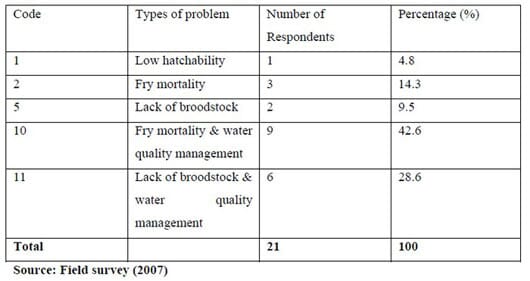
Correlation between quantity of seed produced, age and size of brood stock used for seed production
In table 5 the correlations between the quantities of fish seed produced per month and age and size of brood stock used are shown. Correlation coefficients between the quantity of fish seed produced and broodstock size and age are .028 and -.111, respectively.
Table 5: Correlation between quantity of fish seed produced and age and size of broodstock used for spawning

Table 6 describes monthly fish seed production of the respondents. Over 80 per cent of respondents produced between 1,000 and 40,000 fish seed per month, while only about 5 per cent produced over 60,000 hatchlings per month.
Table 6: Monthly production of fish seed by respondents
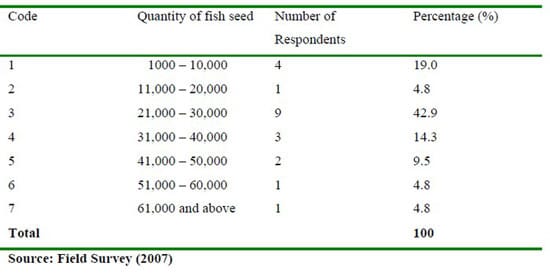
Conclusion
The availability of high quality fish seed is a pre-requisite for a successful aquaculture fish production enterprise. Aquaculture is vigorously being developed in Nigeria today, particularly to bridge the gap between fish demand and supply. The sustainability (i.e. the continuous profitable production) of fish seed production and aquaculture development in Nigeria is dependent not only on production factors (capital, manpower) but also on social (relationships with other enterprises, government policies and regulations, meeting consumers’ needs) and impacts on the environment.
Broodstock quality (age and size) were found to affect fish seed production and quality. Broodstock is obtained either from the wild or from research centers where they are constantly being developed to meet the needs of the industry, thus the importance of technical knowhow for a viable and sustainable industry cannot be over-emphasized. On the other hand, the quality of wild stocks is determined by prevailing environmental conditions and strategies employed in inland fisheries management. Many of the respondents complained that broodstock were not readily available, possibly because of the crisis of reduced fishing effort and lower fish production levels in Nigerian inland fisheries.
Results in this study clearly demonstrate that there has to be a synergy between production, environmental and social factors before sustainability can be achieved in Nigerian aquaculture. Thus, for sustainable fish seed production and aquaculture development, impacts of the fish hatchery enterprise on society, environment and other stakeholders should be positive. According to Seaver (2011), seafood sustainability is determined majorly by the impacts of the seafood on its consumers.
At the global level aquaculture production has been increasing steadily since 1990 in response to declining capture fisheries production. The trend is similar in Nigeria because of inland aquaculture’s potential for food security, livelihood and development. It is estimated that Nigeria needs to produce at least 700,000 metric tonnes (Winrock International, 2010) of fish annually to eliminate its dependency on fish importation. According to Obiyai and Ekubo (2011), Government should encourage more involvement in the fish farming business, create an enabling financial environment to increase investment in fish breeding and hatching operations to reduce the incidence of fingerling shortage in supply which will be counterproductive to aquaculture development in Nigeria.
It could be deduced from the present study that major constraints to the production of high quantity of fish seed are energy and water quality related problems arising from skills gap in the industry.
Recommendations
The production of high quality fish seed requires improved breeding techniques and procedures, thus it is expedient that fish seed hatchery operators invest in regular training and capacity building programmes that will improve their skills. This may require that Government agencies and ministries organize regular and mandatory training workshops and seminars for hatchery operators. Hatchery operation is also a highly technical enterprise which Government needs to regulate and open only to highly skilled and qualified people. Hatchery equipment and inputs are expensive. To enhance fish seed production and aquaculture development in Ogun state and Nigeria, Government may need to subsidize the prices of imported hatchery equipment and inputs.
August 2013


